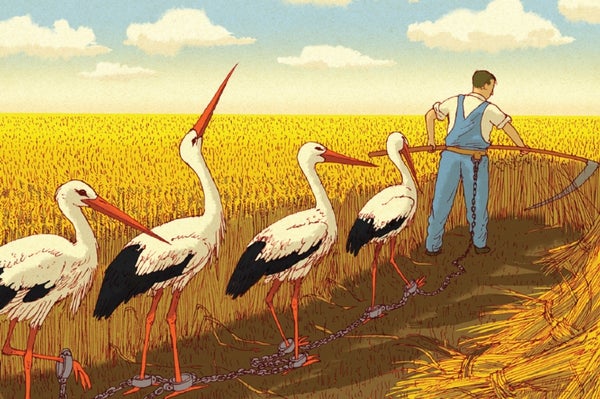If by fiat I had to identify the most consequential ideas in the history of science, good and bad, in the top 10 would be the 1798 treatise An Essay on the Principle of Population, by English political economist Thomas Robert Malthus. On the positive side of the ledger, it inspired Charles Darwin and Alfred Russel Wallace to work out the mechanics of natural selection based on Malthus's observation that populations tend to increase geometrically (2, 4, 8, 16 …), whereas food reserves grow arithmetically (2, 3, 4, 5 …), leading to competition for scarce resources and differential reproductive success, the driver of evolution.
On the negative side of the ledger are the policies derived from the belief in the inevitability of a Malthusian collapse. “The power of population is so superior to the power of the earth to produce subsistence for man, that premature death must in some shape or other visit the human race,” Malthus gloomily predicted. His scenario influenced policy makers to embrace social Darwinism and eugenics, resulting in draconian measures to restrict particular populations' family size, including forced sterilizations.
In his book The Evolution of Everything (Harper, 2015), evolutionary biologist and journalist Matt Ridley sums up the policy succinctly: “Better to be cruel to be kind.” The belief that “those in power knew best what was good for the vulnerable and weak” led directly to legal actions based on questionable Malthusian science. For example, the English Poor Law implemented by Queen Elizabeth I in 1601 to provide food to the poor was severely curtailed by the Poor Law Amendment Act of 1834, based on Malthusian reasoning that helping the poor only encourages them to have more children and thereby exacerbate poverty. The British government had a similar Malthusian attitude during the Irish potato famine of the 1840s, Ridley notes, reasoning that famine, in the words of Assistant Secretary to the Treasury Charles Trevelyan, was an “effective mechanism for reducing surplus population.” A few decades later Francis Galton advocated marriage between the fittest individuals (“What nature does blindly, slowly, and ruthlessly man may do providently, quickly and kindly”), followed by a number of prominent socialists such as Sidney and Beatrice Webb, George Bernard Shaw, Havelock Ellis and H. G. Wells, who openly championed eugenics as a tool of social engineering.
On supporting science journalism
If you're enjoying this article, consider supporting our award-winning journalism by subscribing. By purchasing a subscription you are helping to ensure the future of impactful stories about the discoveries and ideas shaping our world today.
We think of eugenics and forced sterilization as a right-wing Nazi program implemented in 1930s Germany. Yet as Princeton University economist Thomas Leonard documents in his book Illiberal Reformers (Princeton University Press, 2016) and former New York Times editor Adam Cohen reminds us in his book Imbeciles (Penguin, 2016), eugenics fever swept America in the early 20th century, culminating in the 1927 Supreme Court case Buck v. Bell, in which the justices legalized sterilization of “undesirable” citizens. The court included prominent progressives Louis Brandeis and Oliver Wendell Holmes, Jr., the latter of whom famously ruled, “Three generations of imbeciles are enough.” The result: sterilization of some 70,000 Americans.
Science writer Ronald Bailey tracks neo-Malthusians in his book The End of Doom (St. Martin's Press, 2015), starting with Paul Ehrlich's 1968 best seller The Population Bomb, which proclaimed that “the battle to feed all of humanity is over.” Many doomsayers followed. Worldwatch Institute founder Lester Brown, for example, declared in 1995, “Humanity's greatest challenge may soon be just making it to the next harvest.” In a 2009 Scientific American article he affirmed his rhetorical question, “Could food shortages bring down civilization?” In a 2013 conference at the University of Vermont, Ehrlich assessed our chances of avoiding civilizational collapse at only 10 percent.
The problem with Malthusians, Bailey writes, is that they “cannot let go of the simple but clearly wrong idea that human beings are no different than a herd of deer when it comes to reproduction.” Humans are thinking animals. We find solutions—think Norman Borlaug and the green revolution. The result is the opposite of what Malthus predicted: the wealthiest nations with the greatest food security have the lowest fertility rates, whereas the most food-insecure countries have the highest fertility rates.
The solution to overpopulation is not to force people to have fewer children. China's one-child policy showed the futility of that experiment. It is to raise the poorest nations out of poverty through democratic governance, free trade, access to birth control, and the education and economic empowerment of women.
